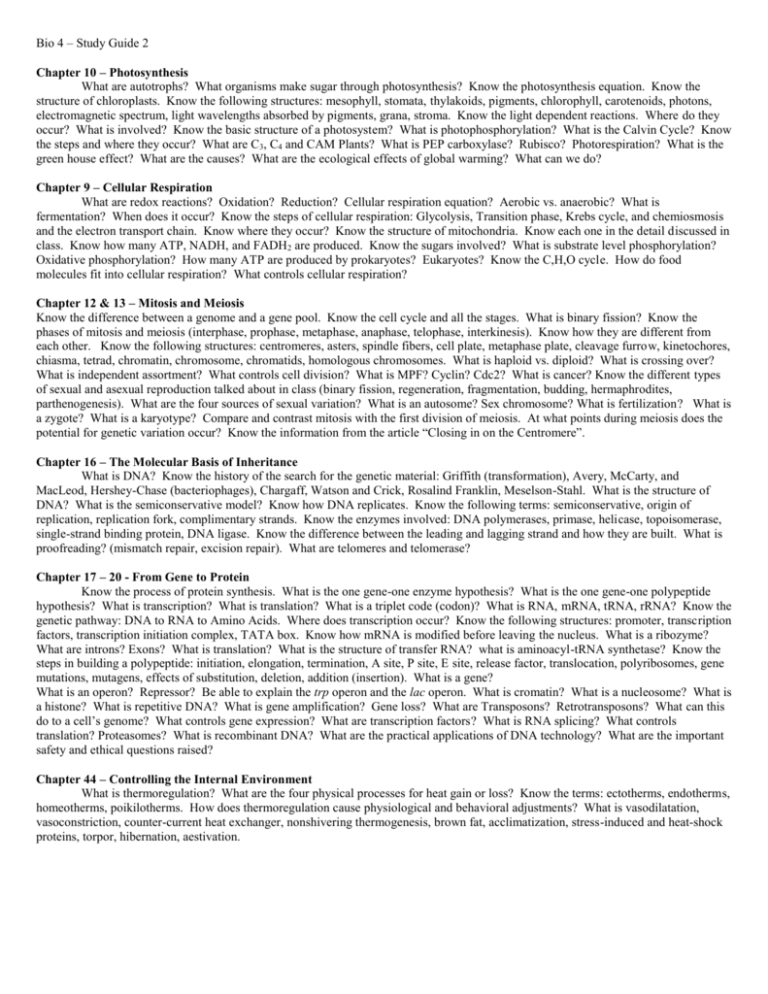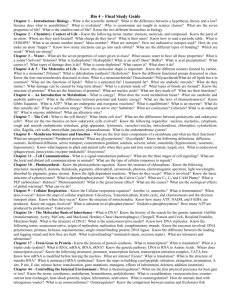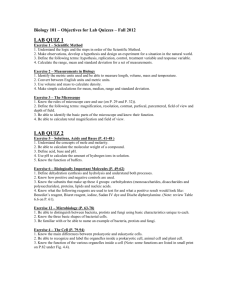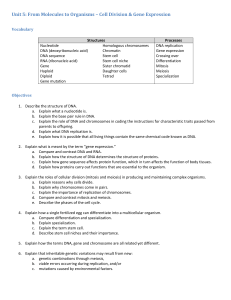Bio 4 * Study Guide 2
advertisement

Bio 4 – Study Guide 2 Chapter 10 – Photosynthesis What are autotrophs? What organisms make sugar through photosynthesis? Know the photosynthesis equation. Know the structure of chloroplasts. Know the following structures: mesophyll, stomata, thylakoids, pigments, chlorophyll, carotenoids, photons, electromagnetic spectrum, light wavelengths absorbed by pigments, grana, stroma. Know the light dependent reactions. Where do they occur? What is involved? Know the basic structure of a photosystem? What is photophosphorylation? What is the Calvin Cycle? Know the steps and where they occur? What are C3, C4 and CAM Plants? What is PEP carboxylase? Rubisco? Photorespiration? What is the green house effect? What are the causes? What are the ecological effects of global warming? What can we do? Chapter 9 – Cellular Respiration What are redox reactions? Oxidation? Reduction? Cellular respiration equation? Aerobic vs. anaerobic? What is fermentation? When does it occur? Know the steps of cellular respiration: Glycolysis, Transition phase, Krebs cycle, and chemiosmosis and the electron transport chain. Know where they occur? Know the structure of mitochondria. Know each one in the detail discussed in class. Know how many ATP, NADH, and FADH2 are produced. Know the sugars involved? What is substrate level phosphorylation? Oxidative phosphorylation? How many ATP are produced by prokaryotes? Eukaryotes? Know the C,H,O cycle. How do food molecules fit into cellular respiration? What controls cellular respiration? Chapter 12 & 13 – Mitosis and Meiosis Know the difference between a genome and a gene pool. Know the cell cycle and all the stages. What is binary fission? Know the phases of mitosis and meiosis (interphase, prophase, metaphase, anaphase, telophase, interkinesis). Know how they are different from each other. Know the following structures: centromeres, asters, spindle fibers, cell plate, metaphase plate, cleavage furrow, kinetochores, chiasma, tetrad, chromatin, chromosome, chromatids, homologous chromosomes. What is haploid vs. diploid? What is crossing over? What is independent assortment? What controls cell division? What is MPF? Cyclin? Cdc2? What is cancer? Know the different types of sexual and asexual reproduction talked about in class (binary fission, regeneration, fragmentation, budding, hermaphrodites, parthenogenesis). What are the four sources of sexual variation? What is an autosome? Sex chromosome? What is fertilization? What is a zygote? What is a karyotype? Compare and contrast mitosis with the first division of meiosis. At what points during meiosis does the potential for genetic variation occur? Know the information from the article “Closing in on the Centromere”. Chapter 16 – The Molecular Basis of Inheritance What is DNA? Know the history of the search for the genetic material: Griffith (transformation), Avery, McCarty, and MacLeod, Hershey-Chase (bacteriophages), Chargaff, Watson and Crick, Rosalind Franklin, Meselson-Stahl. What is the structure of DNA? What is the semiconservative model? Know how DNA replicates. Know the following terms: semiconservative, origin of replication, replication fork, complimentary strands. Know the enzymes involved: DNA polymerases, primase, helicase, topoisomerase, single-strand binding protein, DNA ligase. Know the difference between the leading and lagging strand and how they are built. What is proofreading? (mismatch repair, excision repair). What are telomeres and telomerase? Chapter 17 – 20 - From Gene to Protein Know the process of protein synthesis. What is the one gene-one enzyme hypothesis? What is the one gene-one polypeptide hypothesis? What is transcription? What is translation? What is a triplet code (codon)? What is RNA, mRNA, tRNA, rRNA? Know the genetic pathway: DNA to RNA to Amino Acids. Where does transcription occur? Know the following structures: promoter, transcription factors, transcription initiation complex, TATA box. Know how mRNA is modified before leaving the nucleus. What is a ribozyme? What are introns? Exons? What is translation? What is the structure of transfer RNA? what is aminoacyl-tRNA synthetase? Know the steps in building a polypeptide: initiation, elongation, termination, A site, P site, E site, release factor, translocation, polyribosomes, gene mutations, mutagens, effects of substitution, deletion, addition (insertion). What is a gene? What is an operon? Repressor? Be able to explain the trp operon and the lac operon. What is cromatin? What is a nucleosome? What is a histone? What is repetitive DNA? What is gene amplification? Gene loss? What are Transposons? Retrotransposons? What can this do to a cell’s genome? What controls gene expression? What are transcription factors? What is RNA splicing? What controls translation? Proteasomes? What is recombinant DNA? What are the practical applications of DNA technology? What are the important safety and ethical questions raised? Chapter 44 – Controlling the Internal Environment What is thermoregulation? What are the four physical processes for heat gain or loss? Know the terms: ectotherms, endotherms, homeotherms, poikilotherms. How does thermoregulation cause physiological and behavioral adjustments? What is vasodilatation, vasoconstriction, counter-current heat exchanger, nonshivering thermogenesis, brown fat, acclimatization, stress-induced and heat-shock proteins, torpor, hibernation, aestivation.











